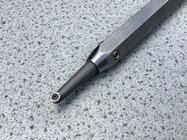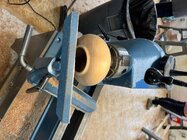Thank you!Maggie, how about watching some YouTube videos of Traditional Japanese wood turning. They often turn in reverse and many if not most seem to make their own tools. I’m not suggesting you make your own but perhaps a local blacksmith could make some tools for you? They don’t look particularly difficult to make. Exactly how well they would work on Green Wood I don’t know, but they certainly wouldn’t clog. I’ll post some links.
View: https://youtu.be/pqK-txM6iwU
View: https://youtu.be/DqYxnDWmqys
View: https://youtu.be/usgwah09_jQ
-
October 2025 Turning Challenge: Natural Edge Bowl! (click here for details) -
Congratulations to Curt Fuller for "Bell Ornaments" being selected as Turning of the Week for October 27, 2025 (click here for details) -
Welcome new registering member. Your username must be your real First and Last name (for example: John Doe). "Screen names" and "handles" are not allowed and your registration will be deleted if you don't use your real name. Also, do not use all caps nor all lower case.
You are using an out of date browser. It may not display this or other websites correctly.
You should upgrade or use an alternative browser.
You should upgrade or use an alternative browser.
Hollowing tool recommendation for green reverse-turning?
- Thread starter Maggie Shapiro
- Start date
Some Traditional Japanese Woodturning Tools.
Every time I see those hook tools my first thought is "Those are positively medieval"
Thank you - I'm curious to know your likes/dislikes for these tools? I'm really leaning towards them.if it clogs you may have to widely open, this will rapidly clog it. Green wood, try a Pro-Forme from Woodcut, wont clog and on green wood you can open it up to 1.5mm plus and really hog out the excess.

Pro-Forme Hollowing Tools for Professional Woodturning | Woodcut Tools
Explore our Pro-Forme hollowing tools, meticulously designed for professional woodturning. Discover Woodcut Tools' high-quality Pro-Forme tools and elevate your craftsmanship in hollowing projects.www.woodcut-tools.com
I have both and they both work well but like all tools there are limitations that need to be considered.
That sounds good - what kind do you like? And are they grabby/do they catch easily?I would really like to test this, but I wont be buying a Munro tool. The 3/16” square scraper cutters go through green wood pretty fast, and generate curls not dust. They are much faster than the cupped carbide cutters in my use. The cupped barbide are good for smoothing and getting to final wall thickness.
I like the small 6mm cupped cutters for hollowing. They can be quite aggressive on seasoned wood but you can adjust the cutting angle to make it less so.
I’ve not tried them on green wood though. I make my own tools but this is one of the commercial ones in use.
One of my shop made tools with the 6mm insert.

I’ve not tried them on green wood though. I make my own tools but this is one of the commercial ones in use.
One of my shop made tools with the 6mm insert.

Maggie, I own both and mainly turn hollow vessels, some fairly deep around 400mm. The Rolly Munro works really well within its limits, ie He recommends .25mm cut and generally a bit lower on the speed than you would normally think. How slow? Well, much depends on the species you are turning, and I turn mainly Australian hardwood. So for me its under 1000rpm and often down at 5-600. I use it as a finishing tool and or small pieces like my avatar, this piece was around 100x100 or 4x4" in Solomon Island Queen Ebony. I find for small pieces its ideal as it has a small head compared to the Pro-Forme. The shaft at 16mm matches the head well and the handle is comfortable and long.Thank you - I'm curious to know your likes/dislikes for these tools? I'm really leaning towards them.
The Woodcut Pro-Forme, I bought only the Head and build my own shaft and handle. This is the cheapest option, in fact I have two Pro-Forme heads. The learning curve might be a bit steep for some in finding and keeping the sweet spot. But once you're there, its very easy. It can be opened up 1.5mm on green wood and its one of the fastest hollowingtools for bulk removal that I know of. But it has a tendency to self feed especially of green wood with a wide open cut, this is easily countered by rolling the tool counter clock wise on to the shield, you dont need much roll and its very easy to control. On long slender vases its quite effective closed down and using slow pulling cut out of the vase. The Pro-Form is capable of good finishing cuts when you close it down.
Both Hollowers for me are fiddly to adjust, so thats why I have multiple. The Wunderkutt 10 is set on his recommended .25mm and I dont change, surprisingly it still hollows quickly and effectively. The Pro-Forme I do adjust some, generally from side cutting to end cutting, end cutting for me is often end grain hollowing in hardwood. I dont like it too aggressive in deep vases or hollow forms.
The only other thing I can think of is lathe height, as I exclusively turn hollow forms. I have found the height of the lathe can help a lot if you raise it up, so the centre line is comparable to your arm pit,. OK this is way higher than anybody will suggest. But at this height the tool handle fits comfortably in the arm pit and is very secure and allows two hands for turning and of course you move the body rather than your hands. This suit hollowing tools but not really gouge hollowing, I gave up hollowing with a gouge several years a go for hollowers and now I probably have 6-8 hollowers, along with a scraper system I have developed for the deep pieces. The pierced pieces I sand the full length internally
Kevin Jesequel
TOTW Team
You don’t need the outboard. You can rotate the headstock to the second position and the banjo/tool rest will reach the opening of a hollow form just fine. I bought the VL240 for this reason.Haha thanks Jim. As soon as I have the outboard set up I’ll start doing that

This isn’t my lathe, but I have been teaching classes the last few days in Vancouver B.C. Using a VL175SH, which is the predecessor to the VL240. Here you can see the headstock rotated out the the second position without any trouble reaching inside the hollowform.

On rereading I got the impression that she was responding to a jokey suggestion that she had a new VL240, otherwise she would likely be using it as suggested. For handheld following or using a banjo mounted captured hollower a swivelling headstock, short outboard table or sliding head lathe would work well.You don’t need the outboard. You can rotate the headstock to the second position and the banjo/tool rest will reach the opening of a hollow form just fine. I bought the VL240 for this reason.
This isn’t my lathe, but I have been teaching classes the last few days in Vancouver B.C. Using a VL175SH, which is the predecessor to the VL240. Here you can see the headstock rotated out the the second position without any trouble reaching inside the hollowform.View attachment 80865
